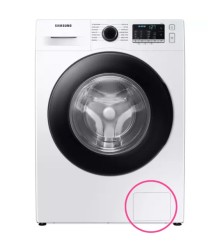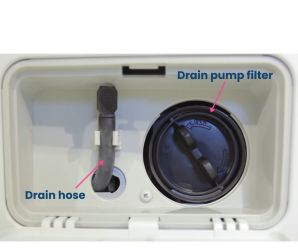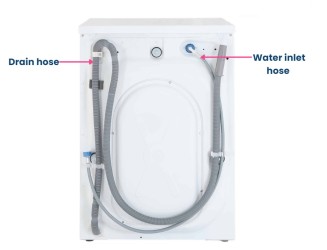What to do if your washing machine door won't open
It can be very frustrating when you finish a load of washing and try to take your clothes out but the washing machine door won’t open. This is a common problem that can often be fixed just by waiting a few minutes. If you have waited a while and the door still won’t open, then there could be a deeper issue that needs investigating.
Last updated - 21/10/2022
Estimated reading time - 7 minutes
What should I do if my washing machine door won't open?
Check if there is water in the drum
The most common reason why a washing machine door won’t open is because there is still water inside the drum. Your washing machine fills with water during the wash and rinse cycles and drains the water during the spin cycle. The interlock, or door lock, acts as a safety mechanism and won’t open while the washing is going through cycles. Even after the washing cycles are completed, the door lock will not release if there is still water in the machine.
If you have finished your washing and you can still see water in the drum, try running a spin cycle. If this fails, you can drain the washing machine manually. You can find out how to do this in the next section of this article.
Possible reasons why my washing machine door won’t open
The washing machine isn’t draining
If your washing machine door won’t open, it could be because it is unable to drain water. Most washing machines’ doors will not open until all the water inside has been drained. If the wash has come to the end of the cycle and you can still see water in the drum, it is likely that this is the cause of the door not opening.
A blocked drain pump filter or a blocked drain hose is a common reason why a washing machine won’t drain.
Your washing machine’s drain pump filter stops obstructions from interfering with the washer. Obstructions such as coins, hair bands, or other items that you may have forgotten to take out of your clothes before you put them in the washing machine will end up in the drain pump filter. A buildup of excess laundry detergent and fabric conditioner could also end up in the drain pump filter. A buildup of items inside the drain pump filter will clog it and the water from your washing machine will not be able to drain.
The drain hose carries wastewater out of your washing machine, and like the pump filter, if obstructions are blocking it, water will not be able to drain properly and could be the reason why your washing machine door won’t open.
Follow these steps to drain your washing machine:
- Turn off and unplug your washing machine.
- Get a bucket and a shallow container, and lay down some towels in case there are any spills or leaks.
- Locate the drain pump filter and drain hose. Most front load washing machines will have a separate drain hose next to the drain pump filter. You can find the drain pump filter and drain hose behind a flap on the bottom corner of the front of your washing machine (see image).
- If your washing machine has a drain hose next to the pump filter, pull it out and place its end in the bucket. When you are ready to drain the water, unscrew the cap on the end of the drain hose.
- If there is no drain hose on the front of the washing machine, place the shallow container directly underneath the drain pump filter and slowly turn the knob until water comes out.
- Continue until no more water is coming out of the drain hose or pump filter.


Now that you have drained your washing machine, follow these steps to clear the drain pump filter of any obstructions:
- Pull out the drain pump filter.
- Clear the filter of any obstructions.
- Once you have cleared the filter of obstructions, run it under some water and give it a clean. Be sure to clear it of any residue and then wipe it dry.
- Put the filter back in the washing machine and turn the knob to lock it in place.
- Close the flap.
- Clear up any spills.
If your washing machine does not have a drain hose at the front, follow these steps to drain it via the drain hose at the back:
- Turn off and unplug the washing machine.
- Get a bucket and lay down some towels around the machine in case there is a spill.
- If you have a freestanding washing machine, pull it away from the wall and locate the drain hose at the back of the washing machine. There might be as many as three hoses connected to the washing machine - a hot water inlet, a cold water inlet, and the drain hose. The drain hose is the grey one (see image).
- Follow the drain hose to find where it leads. It is usually plumbed into a u-bend under the sink, and can be unclamped or unscrewed.
- Detach the drain hose and place its end in your bucket. Water from inside the washing machine should now be draining into the bucket.
- Once no more water is draining, reattach the drain hose to the u-bend and mop up any spillages. Push your washing machine back into place.
- Plug your washing machine back in and wait a few minutes before checking to see if the door is able to open.

A faulty pressure switch
The pressure switch on a washing machine measures how much water is in the drum. If it detects that there is still some water in the drum, the washing machine door won’t open until the water has drained.
If at the end of a wash the pressure switch doesn’t reset, it will keep the door lock energised and you will not be able to open the door. If this is the case, turn off the washing machine at the mains and leave it to cool down for 5-10 minutes before turning it on again and trying to open the door.
If the pressure switch is faulty, it will not be able to correctly detect if there is or isn’t any water left inside the washing machine and will not allow the door to be opened. A faulty or damaged pressure switch will need to be replaced by a trained appliance engineer.
Let us fix your washing machine.
At Smart Plan we have thousands of engineers up and down the country who are ready to fix your issue. We guarantee an engineer to your property within 48 hours.
The door or lid switch is faulty
Front-load washing machines have a switch behind the door lock that tells the washing machine’s control board when the door is open or shut. When the door is shut, a signal will be sent to the control board to let it know that it is safe to continue the washing process.
Similarly to the door switch on a front loader, the lid switch on a top-load washing machine tells the control board if the lid is open or closed.
If your washing machine’s door or lid switch is faulty, it could be incorrectly telling the control board that it is not safe to open, and as a result, the washing machine door won’t open.
If you’re not an appliance engineer, diagnosing a faulty door switch may be difficult. An appliance engineer will be able to locate the door switch and test its electrical output, look for signs of wear and tear around the wires, check for loose connections, and fix it if necessary.
If you are confident with appliance repairs, you can test the door or lid switch with a multimeter. A multimeter is a handheld device used to measure electrical voltage, current, and resistance, and will be able to test if your switch is working.
Click here to find out how to test and replace a door or lid switch on a washing machine.
The washing machine has overheated
Modern washing machines that have been well maintained should not overheat. However, if they do, it can cause the circuits on the washer’s door to stop working. Overheating can happen if your washing machine has been used a few times in a short period of time. If overheating has caused the door lock’s circuits to malfunction, the door lock may not receive the signal from the control board that tells it that it is safe to unlock the door.
If your washing machine door won’t open and you notice it is hot to the touch, unplug the machine by the mains and leave it to cool down for a while. After 30 mins or so, try opening the door again.
Avoid unexpected costs.
With a Smart Plan cover policy, you can rest easy knowing if there's an issue with your washing machine, we'll usually have you back up and running within 48 hours.
My washing machine door still won’t open?
As you have read, there are a few possible reasons why a washing machine door won’t open. Getting to the root cause can be difficult and time-consuming. The best way to find out the exact reason is to call in an appliance engineer. An appliance engineer will be able to diagnose and fix the issue.

